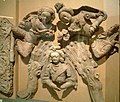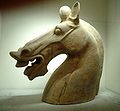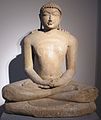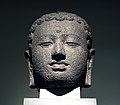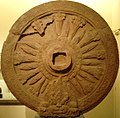Guimet Museum
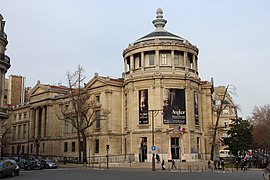 The museum in December 2013 | |
| Established | 1879 |
|---|---|
| Coordinates | 48°51′55″N 2°17′38″E / 48.86528°N 2.29389°E |
| Type | Asian art |
| Website | www |
The Guimet Museum (full name in French: Musée national des arts asiatiques-Guimet; MNAAG; abbr. Musée Guimet) is a Parisian art museum with one of the largest collections of Asian art outside of Asia that includes items from Cambodia, Thailand, Viet Nam, Tibet, India, and Nepal, among other countries.
Founded in the late 19th century, it is located in the 16th arrondissement of Paris, France, at 6, place d'Iéna. Its name literally translated into English is the National Museum of Asian Arts-Guimet, or Guimet National Museum of Asian Arts.
History
[edit]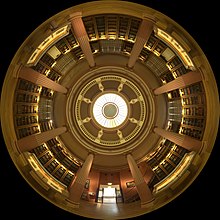
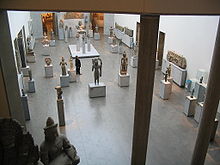
Founded by Émile Étienne Guimet, an industrialist, the museum first opened at Lyon in 1879[1] but was later transferred to Paris, opening in the place d'Iéna in 1889.[2] Devoted to travel, Guimet was in 1876 commissioned by the minister of public instruction to study the religions of the Far East, and the museum contains many of the fruits of this expedition, including a fine collection of Chinese and Japanese porcelain and objects relating not merely to the religions of the East, but also to those of ancient Egypt, Greece and Rome. One of its wings, the Panthéon Bouddhique, displays Buddhist artworks.[citation needed]
Some of the museum's artifacts, originating from Cambodia, are connected with the studies conducted by the first scholars to be interested in Khmer culture, Louis Delaporte and Etienne Aymonier. They sent examples of Khmer art to France at a time when museums were not existing in Southeast Asia, with the agreement of the King of Cambodia, to show to Europe the high level of the ancient Khmer culture.[citation needed]
From December 2006 to April 2007, the museum harboured collections of the Kabul Museum, with archaeological pieces from the Greco-Bactrian city of Ai-Khanoum, and the Indo-Scythian treasure of Tillia Tepe.[citation needed]
In early 2024, the Parliament of the Central Tibetan Administration was joined by a group of Asian scholars published on 03 September by Le Monde,[3] and by the French Senate's Tibet Support Group[4] in strongly criticizing the museum for removing the word "Tibet" from its catalogues and exhibitions.[5] Guimet Museum had changed the appellation of Tibet to "Himalayan World",[4] while a second museum, Musee du Quai Branly changed their appellation of Tibet to the Chinese government's 2023 internal legal term,[3] "Xizang".[5][6][7][8] The use of the name "Xizang" is considered an "historical fraud"[5] by the group of Asian scholars published by Le Monde. By 25 September, Musee du Quai Branly had formally apologized to a delegation of six Tibetan activist groups.[4]
Works of art of the museum
[edit]Greco-Buddhist art
[edit]-
Gandhara Buddha, 1st–2nd century CE
-
Hellenistic decorative scrolls from Hadda, northern Afghanistan
-
Standing Buddha, ancient region of Gandhara, northern Afghanistan, 1st century
-
Wine-drinking and music, Hadda, 1st–2nd century CE
-
A Corinthian capitol with a Buddha at its center, 2nd century, Surk Kotal, Afghanistan
-
Scene of the life of the Buddha. 2nd–3rd century. Gandhara
-
Portraits from the site of Hadda, 3rd century
Serindian art
[edit]-
"Heroic gesture of the Bodhisattva", 6th–7th century terracotta, Tumshuq (Xinjiang)
-
Head of a Bodhisattva, 6th–7th century terracotta, Tumshuq (Xinjiang)
Chinese art
[edit]-
Han dynasty Horse (1st–2nd century)
-
Buddha triad, Eastern Wei (534–550), China
-
Tang dynasty Foreign Merchant
-
Northern Qi depiction of Sogdians
-
One of the Group of glazed pottery luohans from Yixian, c. 1000
-
A sitting celadon lion, dated 11th to 12th century, Song dynasty
-
A porcelain vase with design of men fighting on horseback, from the Jiajing reign period (1521–1567), Ming dynasty
-
A round sancai dish from the Tang dynasty, 8th to 9th century
-
Painting Bodhisattva Who Leads the Way from Mo-kao caves, 900–950 A.D.
Indian art
[edit]-
An aniconic representation of Mara's assault on the Buddha, 2nd century, Amaravati style, eastern India
-
A Buddha, 2nd century, Mathura
-
Buddha of the Gupta period, 5th century, Mathura
-
Head of a Buddha, Gupta period, 6th century
-
Rishabhanatha, sandstone, Madhya Pradesh, Chandela period, 10th–11th century
-
Buddha and Bodhisattvas, 11th century, Pala Empire
-
Vishnu, Madhya Pradesh, 11th–12th century
-
Rishabhanatha, 11th–12th century, Orissa
Southeast Asian art
[edit]-
Agastya, c. 8th–9th century Central Java, Indonesia
-
Brahma 10th century, Khmer art, Cambodia
-
Shiva from Vijayapura, Vietnam
-
Ganesha, Siem Reap, Cambodia, c. 12th–13th century
-
A Cambodian Buddha, 14th century
-
Bodhisattva Lokiteśvara, Cambodia 12th century
See also
[edit]Notes
[edit]- ^ History of the Museum (in French) Archived 2017-08-18 at the Wayback Machine.
- ^ National museum Arts asiatiques – Guimet, Marie-Catherine Rey et al. Paris: Éditions de la Réunion des Musées nationaux, 2001, translation by John Adamson, ISBN 2711838978, Chronology, p. 6.
- ^ a b Op-Ed, Group letter, "French museums are bowing to China's demands to rewrite history and erase peoples' ", Le Monde, 03 September 2024
- ^ a b c Isa Farfan, "Paris Museum Apologizes for Contentious Tibetan Artifact Labels", Hyperallergic, 02 October 2024
- ^ a b c Massimo Introvigne, "Renaming Tibet “Xizang”: Are French Museums Backing Off?", Bitter Winter, 09/24/2024
- ^ "Tibetan Parliament in-exile expresses concern over changes to Tibetan representation in French museums". ThePrint. 2024-09-20. Archived from the original on September 21, 2024. Retrieved 2024-09-21.
- ^ Ovais, Dar (September 19, 2024). "'Xizang' replacing 'Tibet' in French museums: Irked Tibetan govt in-exile flags 'distortion of history'". Hindustan Times. Archived from the original on September 21, 2024. Retrieved September 21, 2021.
- ^ Philip, Bruno (2024-09-27). "French museums and the risk of erasing Tibet". Le Monde. Retrieved 2024-10-22.
External links
[edit]- Musée Guimet
- Musée national des arts Asiatiques Guimet, special issue of art magazine Connaissance des Arts, available in French and English












